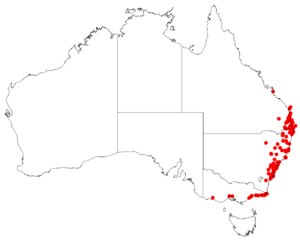Muellerina celastroides facts for kids
Quick facts for kids Muellerina celastroides |
|
|---|---|
| Scientific classification | |
| Genus: |
Muellerina (plant)
|
| Species: |
celastroides
|
 |
|
| Occurrence data from AVH | |
| Synonyms | |
|
Dendrophthoe celastroides (Sieber ex Schult. & Schult.f.) Mart. |
|
Muellerina celastroides, also known as Banksia mistletoe or coast mistletoe, is a unique plant. It's a type of hemiparasitic shrub. This means it grows on other plants and gets some of its water and nutrients from them. It's part of the Loranthaceae family, which are often called mistletoes. You can find this plant growing naturally in New South Wales, Victoria, and Queensland in Australia.
Contents
What Does Banksia Mistletoe Look Like?
Banksia mistletoe can grow upright or spread out. It usually feels smooth. But its flower stalks have tiny, brown, woolly hairs.
Leaves and Flowers
Its leaves are shaped like a long oval. They are about 2.5 to 7 centimeters (1 to 2.7 inches) long. They are also about 1.5 to 2.5 centimeters (0.6 to 1 inch) wide. The tip of each leaf is rounded, and the base narrows down.
The flowers grow in small groups of one to three pairs. Each flower group has three flowers. When the flowers are still buds, they are quite long, about 2.2 to 3.5 centimeters (0.9 to 1.4 inches). The fruit of the Banksia mistletoe looks like a small pear. It is about 7 to 11 millimeters (0.3 to 0.4 inches) long. The fruit starts green and slowly turns light red as it ripens.
Where Does Banksia Mistletoe Grow?
Banksia mistletoe is a hemiparasitic plant. This means it needs to grow on other plants to survive. It attaches itself to a "host" plant. It then takes some water and nutrients from its host.
Host Plants
You can often find Muellerina celastroides growing on certain types of trees. These include Allocasuarina, Banksia, and Eucalyptus species. Sometimes, it even grows on other mistletoes! It can also grow on plants that are not native to Australia.
Butterflies and Mistletoe
This special mistletoe is important for many butterflies. Several types of butterflies use Muellerina celastroides as a host plant. This means the butterfly caterpillars eat its leaves. Some of these butterflies include:
- Delias nigrina
- Delias argenthona
- Hypochrysops digglesii
- Ogyris abrota
- Ogyris zosine
- Candelides margarita
Naming Banksia Mistletoe
The Banksia mistletoe has had a few different names over time. It was first described in 1829 by a scientist named Franz Sieber. He called it Loranthus celastroides. Later, in 1895, another scientist named van Tieghem gave it its current name, Muellerina celastroides.

